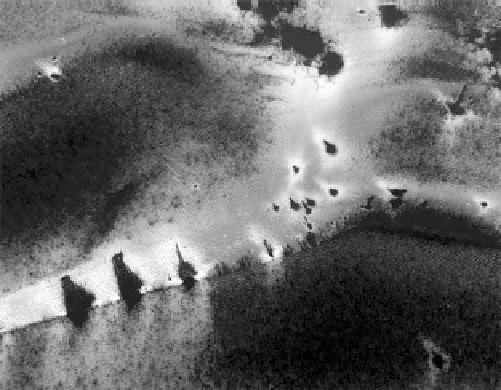Geoscience Reference
In-Depth Information
Fig. 12.18
Rabe crater: Night-time temperature data overlain on a
VIS image of the dunes in Rabe crater, both obtained by the THEMIS
camera on Mars Odyssey. Image NASA/JPL/ASU
Fig. 12.20
CRISM images of dunes in Nili Patera. Top, true color.
Bottom, spectral bands chosen to highlight composition, with red
dunes indicating concentrations of iron- and magnesium-rich igneous
materials. Image PIA009347, NASA/JPL/JHUAPL
Fig. 12.19
Defrosting carbon dioxide frost on the dunes on the floor
of Richardson crater, southern spring. Dark jagged patches are dust
blowouts,
and
white
surrounds
are
frost.
Portion
of
HiRISE
ESP_012774_1080, credit NASA/JPL/U.Arizona
above the level of the crater floor; layered clay-rich mate-
rials near the base of the central uplift (Fig.
12.22
) are the
primary target for the Curiosity rover, which landed in
August 2012 to search for possible organic materials in
sediments from the early history of Mars. The central
mound in Gale crater is surrounded by an arc of dark sand
dunes (orbital imaging of dune field reveals a rather com-
plex wind flow pattern on the crater floor, likely strongly
influenced both by the crater rim and the high central
mound (Silvestro et al. 2013). During 2013-2014, Curiosity
should get many images of a portion of this dune field as it
drives toward a place to provide the rover a safe route to
drive through the dune field. During testing of the Curiosity
aid in the detection of sand dune movement on Earth
(Bridges et al. 2012b; Fig.
12.21
). Remarkably, given the
nondetection of movement on Mars over the Mariner 9 to
Mars Odyssey period of some 35 years, these latest results
indicate that sand movement rates on Mars today are
comparable to documented rates obtained in some places on
Gale crater (5.4 S, 137.8 E). Gale crater is 154 km in
diameter, and is located at the transition from the southern
cratered highlands to the northern lowland plains, south of
the Elysium Mons volcanic center. A massive mound of
material covers the central peak of the crater, rising 5.5 km



Search WWH ::

Custom Search